The Viceroy, Lord Curzon came to India (1899-1905) with a strong determination to stem the rising tide of nationalism. The dominant note of his polity throughout this period was that India must remain a possession of England. He inflicted in almost breathless succession one contemptuous measure after another and it reached the climax, when in 1903, he announced the partition of Bengal, which was considered to be a subtle attack on the growing solidarity of Indian nationalism. It aroused a very strong nationalist sentiment in the whole of Bengal, as they felt humiliated, insulted and tricked. To discontent against the partition led to the swadeshi movement and amidst an unprecedented scene of enthusiasm a resolution was passed at a huge public meeting in Calcutta on August 7, 1905 to boycott British goods and adopt swadeshi. The call for swadeshi, an economic and political campaign, soon spread to the other provinces and made a tremendous impact on India as a whole.
The swadeshi movement gave the extremist group of Indian National Congress a long sought opportunity to act and did something to make the government angry. The British and Foreign goods were boycotted, shops selling Foreign articles and clothes were picketed and public burning and bonfire (holi) of Foreign goods took place. The 1905 Congress session at Varanasi (Benares) passed a resolution endorsing the swadeshi movement and the boycott of British and foreign goods. The moderates in the Congress, however, felt, shy of the idea of boycott, thinking that the term 'boycott' had a sinister moaning and implied a vindictive desire to injure others, though they accepted the idea of swadeshi. But the extremists were of the opinion that the twin ideas of swadeshi and boycott were complimentary to each other, as one could not Succeed without the other.
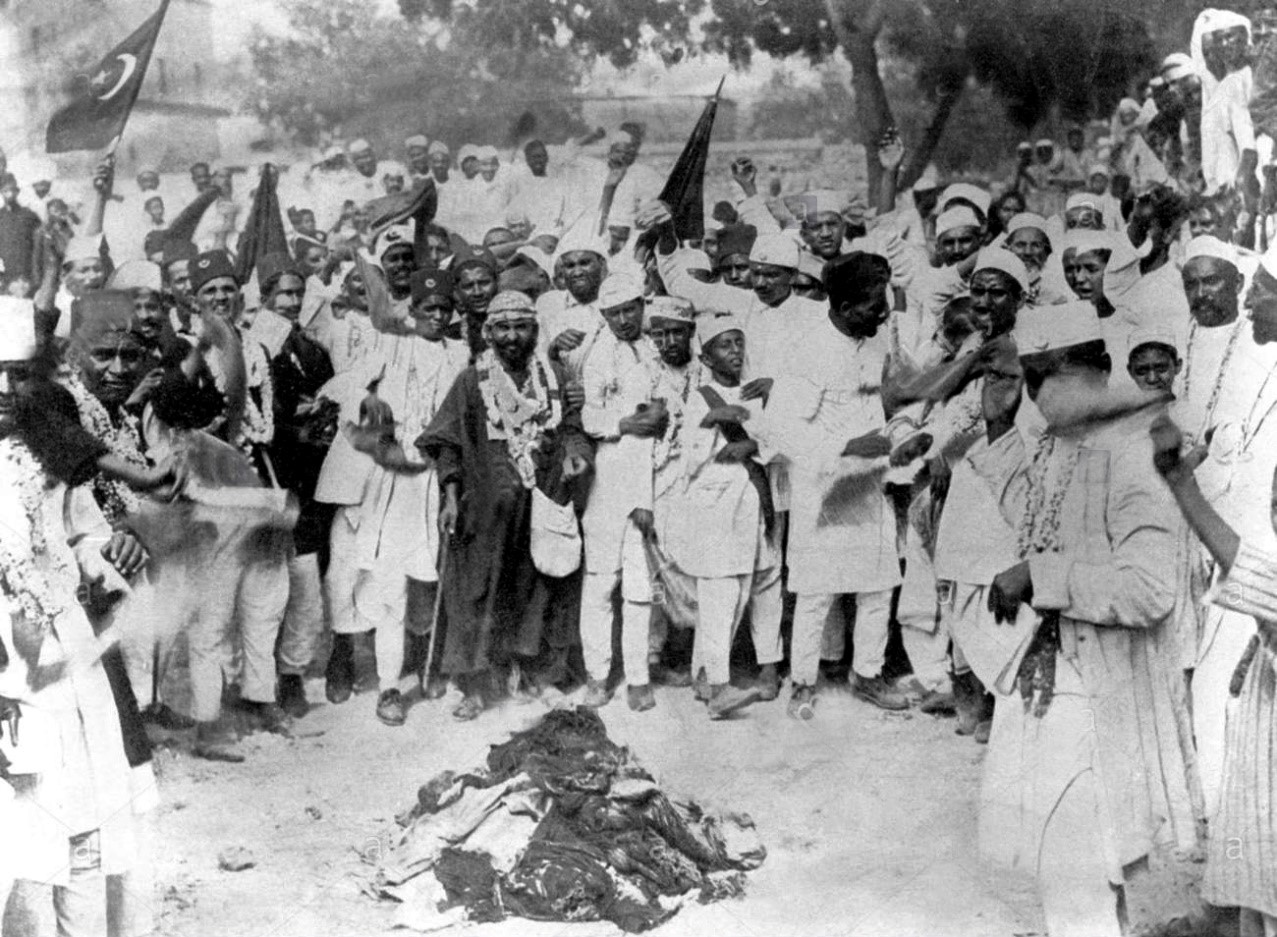
British goods being burnt.
Later, the Swadeshi movement widened from a mere boycott of British floods to a boycott of everything British. Sri Aurobindo Ghose developed the concept of a fourfold boycott: economic, educational, judicial and executive. In 1916, Tilak and Annie Besant formed the Home Rule League and started a spirited campaign for self-government. During the post-war years, Mahatma Gandhi emerged as the foremost leader of the nationalist movement, which took the form of nonviolent, non-cooperation movement. The non-cooperation movement was essentially a revival of the swadeshi movement, it urged people to resign from government offices, shun the British law-courts, withdraw from schools and colleges and boycott the elections. On the positive side, there was a campaign for using indigenous goods, especially Khadi or home-spun cloth. The swadeshi movement was a great fillip to the Indian Industries.
Sometime during 1920s, the Indian National Congress issued the 'Boycott British Goods', 'Boycott Foreign Goods’ and 'Patronize Indian Goods' Labels to publicise the swadeshi and civil disobedience movement. The use of 'boycott' labels on postal article was prohibited by Government notifications. The earliest reference, to those labels is in a note written by Mr. F. Franklin DeSouza, published in the September, 1930 issue of the Philatelic Journal of India, as follows:
“BAN ON 'BOYCOTT STAMPS”
"The protean activities of the Congress have found vent in the issue of labels- which have been retailed at a pie cash and which have for some time now been used on postal articles side by side with ordinary postage stamps. Their Status has attracted the attention of the authorities and a rule has been made under the India Post Act "prohibiting the transmission of articles having thereon, or on the cover thereof', any matter which is pre-judicial to the maintenance of law and order, on which in furtherance of movement which, in the opinion of the Governor-General in Council, is prejudicial to the maintenance of law and order, or any matter which tends directly to cause loss or injury to any community or class of persons, whatsoever. Provision is made for the interception and disposal of any article which is found in the course of transmission by post to contravene in provisions of this rule.”
"The notification will appear in the "Gazette of India" of August 9 and will take effect from that date."
"It is understood That letters or postcards boating "boycott" labels, such as have recently been in evidence, are liable to be destroyed under this rule."
A further Postal Notice (original notice illustrated) was issued by the Director-General of Posts and Telegraphs on 28th May 1936, prohibiting the use of these -labels on the postal articles. However, the labels of unobjectionable character, such as 'Buy Swadeshi Goods' or Support Home Industries' or similar devices adopted for business purposes were permitted to be used. But some articles bearing these prohibited labels did inadvertently pass, through 'post, 'which are very scarce and much sought after by the collectors.
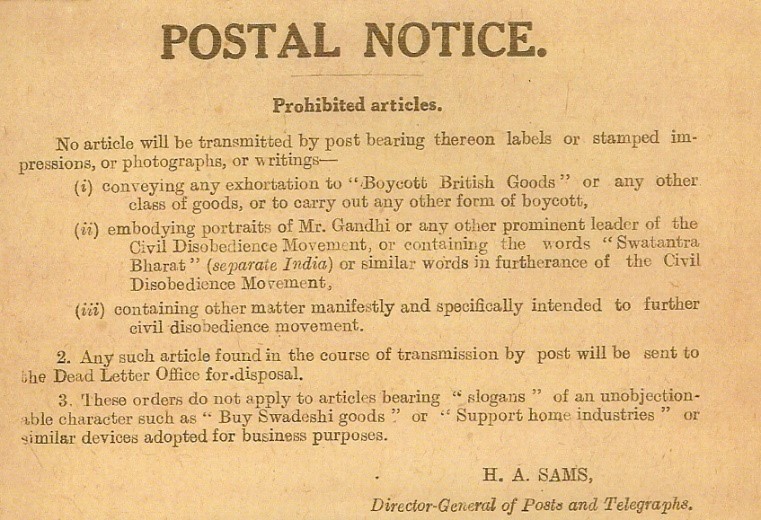
Vide Postal Notice dated 16th August 1930 a rule under section 90 of the Indian Post Office act was made which clearly mentioned that the portrait of Mr. Gandhi and other prominent leaders of the Civil Disobedience Movement or other patriotic inscription on any postal article should not be transmitted and if found will be sent to Dead Letter Office for Disposal.
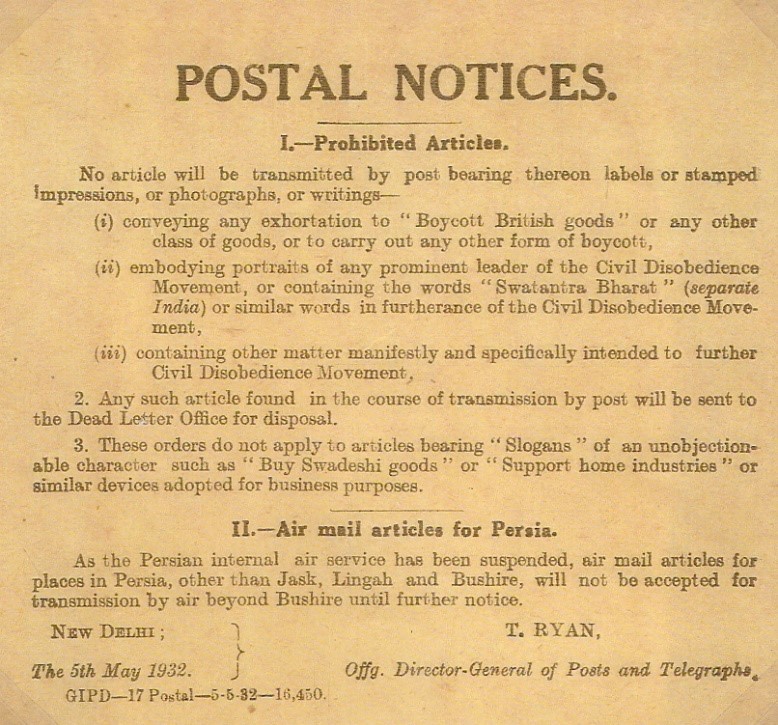
Vide Postal Notice dated 5th May 1932 & 28th May 1936, the circular was again reinforced with the word “Mr.Gandhi” removed.
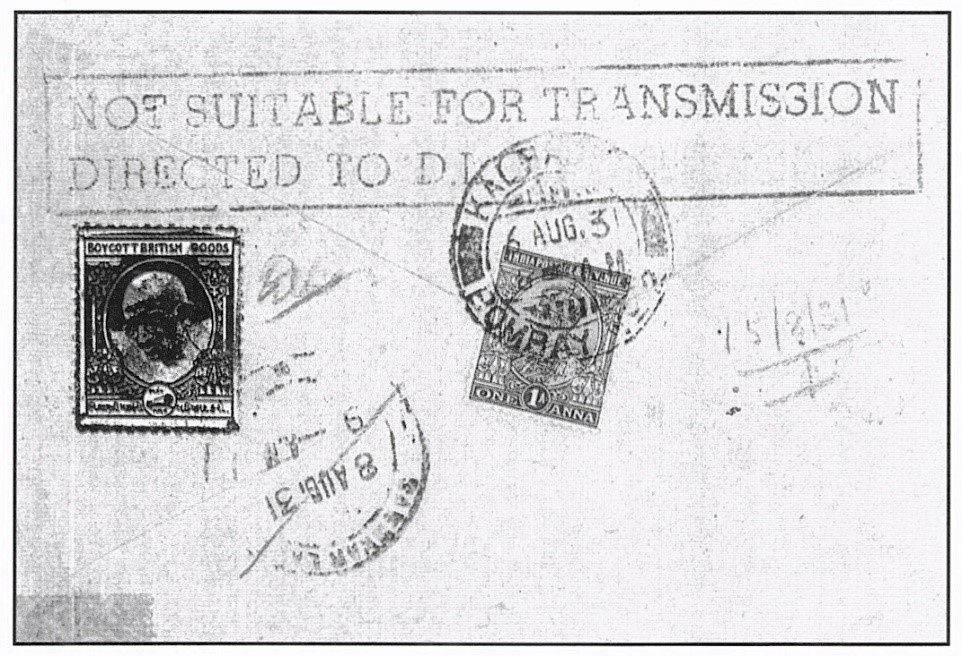
Not Suitable for Transmission Directed to DLO (Dead letter office)” because of attached Boycott label on the letter
These labels are relics of our national freedom struggle and are of considerable philatelic interest also. Here, some readers may disagree with me, thinking that these are more labels of no philatelic importance. But I feel that due to an official ban being put on their use on postal articles, these are of postal history interests.
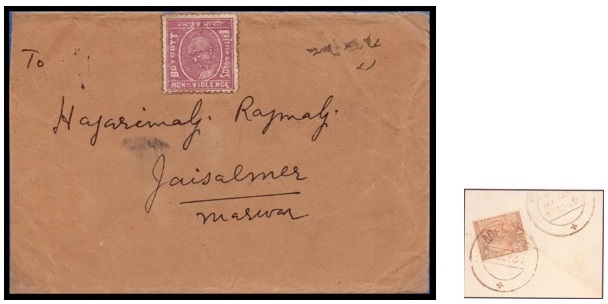
These labels may be broadly classified in two groups: (I) Boycott British or Foreign Goods labels and (II) Patronize Indian Goods labels. I am listing below the different types of these labels known to me, only the main colours have been listed, as colour shades abound.
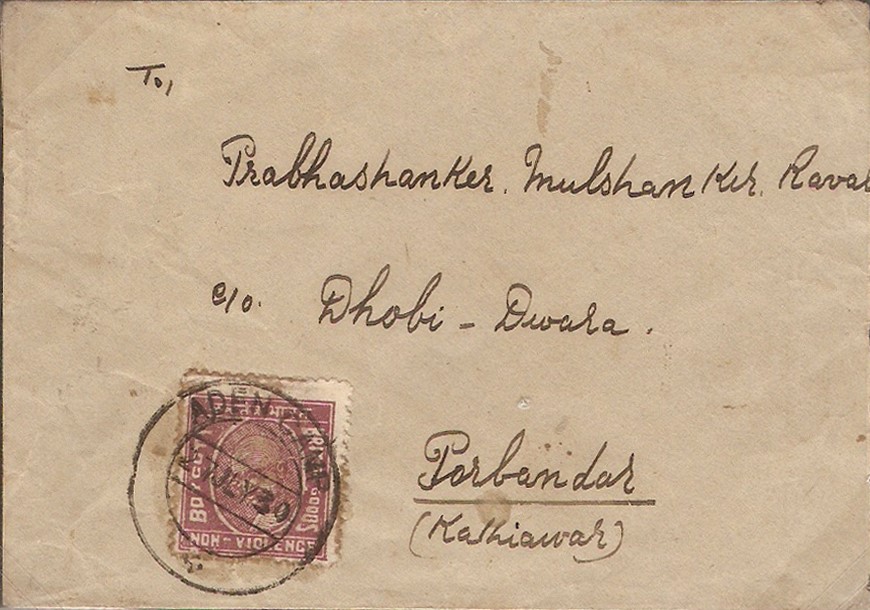
Aden 27.07.1930 - Cover to Porbandar (Birthplace of Mahatma Gandhi) franked on reverse by India King George V 1as and bearing a Gandhi “Boycott British Goods” Label, both cancelled by Aden Camp c.d.s.

George VI as stationery envelope from Bombay dated 6 August 1930 to Beawar bearing circular hand stamp in Gujarati “British Mall No Bahiskar Karo” (Boycott British Goods) and shield type hand stamp in English “Boycott British Goods” in blue. The sender had added in manuscript “& English” after British in both strikes.
I Boycott British or Foreign Goods Labels
Type 1 - Gandhi Portrait with flags on both sides, Hindi inscription 'Swatantra Bharat' (Independent India) at the top in colours red-brown and green
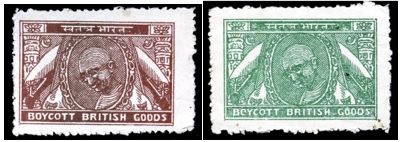
Type 2 - Gandhi Portrait with flags on both sides, but with Hindi inscription 'British Mal Bahiskar Koro' (Boycott British Goods) at the top, imperf in vermillion, orange and light vermillion.
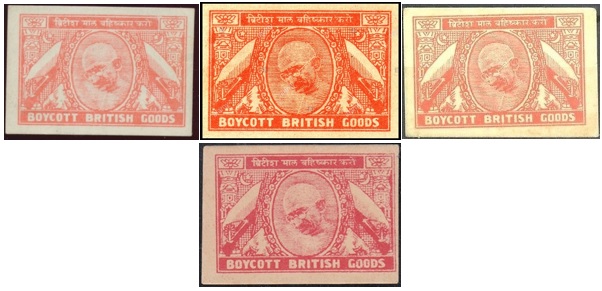
Type 3 - Gandhi Portrait with flags on both sides, but with Hindi inscription 'Videshi Mal Bahiskar Karo' (Boycott Foreign Goods) at the top.

Type 4 - Gandhi Portrait, with Hindi inscription 'Swatantre Bharat' (Independent India) at the top with English Inscription ‘Boycott British Goods red brown
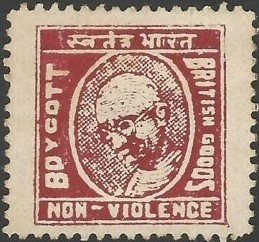
Type 5 - Gandhi Portrait in round 'Boycott British Goods' at the top with other inscription ‘Support Indian Industries’ in green and black-white, blue-brown, blue-light Brown and blue- light blue.

Type 6 - 'Boycott British Goods' at the top with other inscription ‘Support Indian Industries’

Type 7 – Indian Flag with Azad Hindi and wear Khadi, but English inscription ‘Boycott British Goods’

Type 8 - Nehru Portrait, but with Gujarati inscription 'British Malno Bahiskar Karo' (Boycott British Goods) in blue colour
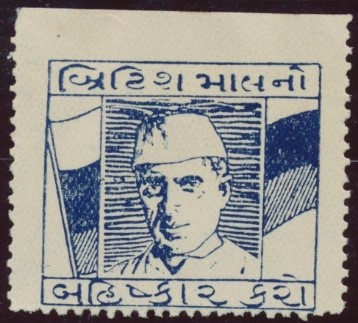
II Patronize Indian Goods
Type 1 - Gandhi Portrait with message “Patronize Indian Goods”

Type 2 – India’s Map with slogan ‘Be Indian Buy Indian’
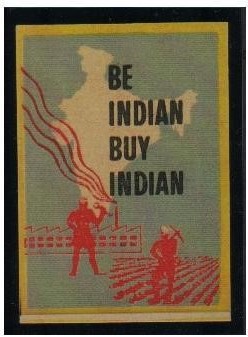
Type 3 - Bharat Mata' (Mother India) and Map with inscription in Hindi and English ‘Buy Swadeshi’
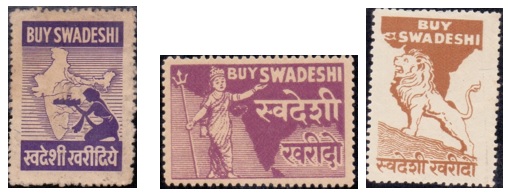
The Effect of these Boycott British Goods Labels caused panic among the officials of the British Government as the goods were set a fire by the masses in support of Gandhi’s call, This led to the issue of an ordinance that prohibited the use of labels on mails spreading propaganda and hence these are rarely found on Indian Mails.
